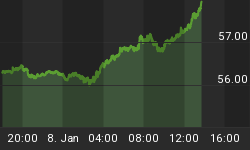The following is excerpted from a commentary originally posted at www.speculative-investor.com on 1st September 2013.
We occasionally see articles where the monetary base is wrongly discussed as if it were akin to the money supply or as if the change in the monetary base indicated the amount of monetary inflation in the economy. We'll now outline the differences between the monetary base and the money supply and explain how these differences are related to the contrasting inflation situations in Japan and the US.
The monetary base (MB) is made up of bank reserves and physical currency (notes and coins). Bank reserves are not counted in the money supply (MS) for the good reasons that a) they are not available for spending and b) they provide 'cover' for money that is available for spending and is counted in the money supply. The physical currency that resides outside the banking system is, of course, available for spending and is naturally counted in the MS as well as in the MB, but these days the combined value of all notes and coins tends to be small relative to the total MS. Also, the total quantity of notes/coins can only increase due to the withdrawal of bank deposits, a process that is always money-supply neutral (every dollar added to the total quantity of physical currency will be offset in the MS calculation by a dollar coming out of a demand or savings deposit). In other words, adding to the supply of physical currency never increases the total money supply.
An implication of the above paragraph is that boosting the monetary base will not boost the money supply. There is an indirect link in that an increase in reserves held at the central bank could prompt commercial banks to lend more money into existence, but the point is that increasing the MB won't immediately put additional money into the economy and won't necessarily even lead to a higher money supply in the future. A related implication is that a large increase in the MB will not necessarily lead to currency depreciation.
The difference between an increase in the MB and an increase in the MS is linked to why the pro-inflation policies of the Bank of Japan (BOJ) have not, over the past 20 years, led to "price inflation" worthy of the name. In Japan, quantitative easing (QE) does not directly expand the money supply; it only expands the monetary base. The BOJ relies on commercial banks and other private financial institutions ramping-up their investing/lending in order to transform a QE-related increase in the MB into a higher MS. As a consequence, the BOJ's QE is not necessarily inflationary.
Up until now the BOJ's QE has not led to much in the way of monetary inflation, which is why it hasn't brought about much in the way of "price inflation". The rate of growth in Japan's money supply has averaged only 2% per year over the past 20 years -- a level of monetary inflation that would be expected to result in no "price inflation" assuming an average annual rate of productivity improvement of at least 2%. In other words, there's no mysterious disconnect between money supply and money purchasing-power at work in Japan. The lack of "price inflation" is exactly what should be expected given the low rate of monetary inflation.
The situation in the US is very different. Whereas the BOJ's QE is not necessarily inflationary, the Fed's QE is always inflationary (meaning: it always increases the money supply, leading to price rises in some parts of the economy, distortions in relative prices, and, eventually, a decline in money purchasing-power). As explained in many previous commentaries, the reason is that when the Fed monetises X$ of assets it adds X$ to bank reserves (part of the MB, but not part of the MS) AND it adds X$ to demand deposits at commercial banks (part of the MS). A consequence is that in the US there is no requirement for commercial banks to expand their lending/investing in order for the money supply to grow, because the Fed is capable of increasing the US money supply by whatever amount it desires regardless of what the commercial banks are doing. It's amazing that very few people understand this.
The bottom line is that the monetary base is not necessarily a good indicator of the monetary inflation situation. The main focus of analysts should therefore be on the change in the money supply, not the change in the monetary base. Unfortunately, not many analysts know how to correctly measure the money supply.
We aren't offering a free trial subscription at this time, but free samples of our work (excerpts from our regular commentaries) can be viewed at: http://www.speculative-investor.com/new/freesamples.html
















